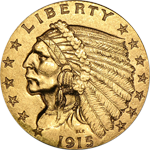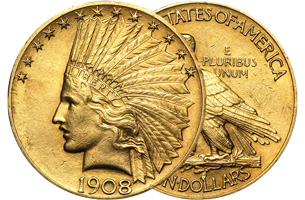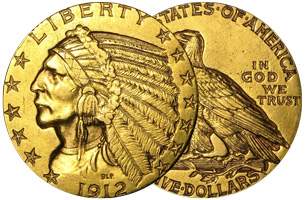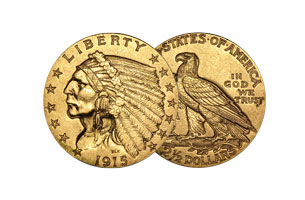The Indian Head gold coin series includes three denominations: the $2.50 coin (quarter eagle), the $5 dollar coin (half eagle), and the $10 coin (eagle). The quarter eagle was struck from 1908 to 1929 (with interruption from 1916-1924), the half eagle was produced from from 1908 to 1929 (with interruption from 1917-1928), and the eagle was minted from 1907 until 1933. The coins were produced by the U.S. Mint, first at the mints in Denver and San Francisco, then later in Philadelphia and New Orleans.
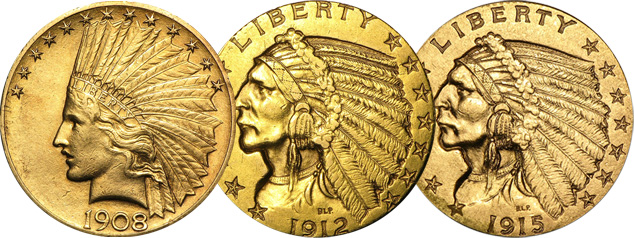
Shortly after his inauguration, President Theodore Roosevelt complained about the artistic quality of American coins and asked his friend Augustus Saint-Gaudens to develop five modern, artistic designs for U.S. coins that could be changed without an Act of Congress: the cent and four gold pieces (the quarter eagle, half eagle, eagle, and double eagle). The Mint Act of 1792 had established that one eagle was equivalent to ten dollars. Furthermore, Roosevelt decided that the eagle and the double eagle would have different designs: The eagle featured Liberty wearing an Indian headdress on the obverse and a perched bald eagle on the reverse; the double eagle featured Liberty striding forward on the obverse and a flying eagle on the reverse. While the Saint-Gaudens did develop the Indian Head eagle and the Saint-Gaudens double eagle, the Indian Head half and quarter eagle were completed by Bela Lyon Pratt after Saint-Gaudens’ death in 1907.
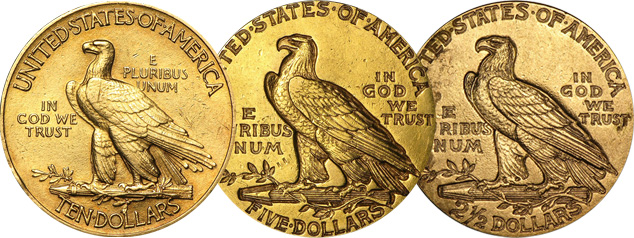
Due to several problems surrounding the production of the eagle and the double eagle, the smaller half eagle and quarter eagle coins were disregarded until late 1907. It turned out to be difficult to engrave all the legends required by law on the small pieces. Pratt used a new method of incused instead of raised engravings, so the coins could be easily stacked. He also modified the small pieces by using the eagle’s obverse design, but he chose a Native American man rather that Saint-Gaudens’ female Liberty. The Native American wears a headdress and faces left. In addition, the obverse side features the designer’s initials “BLP” and the mint date. The reverse side shows an eagle standing on some arrows and holding an olive branch in its left talon. The mintmark is located left if the arrowheads, while the denomination can be found below the arrows.
All gold eagles contain 90% gold and 10% copper.
The new design posed considerable difficulties for the mints in Denver and New Orleans. The incused design made the coins thinner than earlier versions of their denomination; thus, automated sorting machines could not reliably sort them when mixed with earlier coins. The new coins were received with some negative comments; numismatist Samuel Chapman, for instance, argued that the indentations would trap dirt and germs and could get people sick. He also claimed that the coins could be easily counterfeited and that the depicted Indian looked too “emaciated.”
Indian Head coins did not circulate much, although the quarter eagle had become a popular Christmas gift. As the establishment of the Federal Reserve System in 1913 increased the circulation of banknotes, the Mint stopped to produce quarter eagles after 1915 and half eagles after 1916. Additionally, the economic unrest of WWI caused gold prices to spike, so gold coins quickly disappeared from circulation. However, the quarter eagle was struck again in 1925, as gold coins were still popular gifts, until its production was completely halted due to the Great Depression. The half eagle was struck one more time in 1929 until Roosevelt stopped the issuance of gold coins entirely. He also recalled many Indian Head pieces in 1933.

